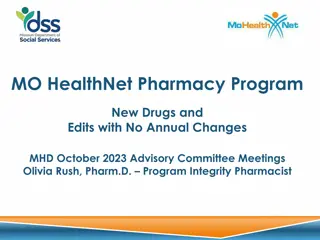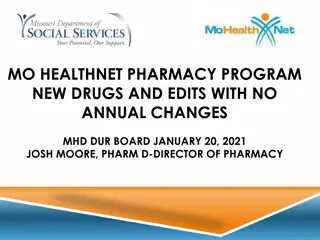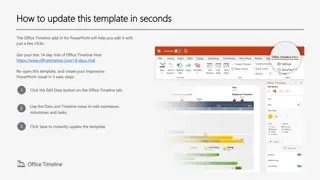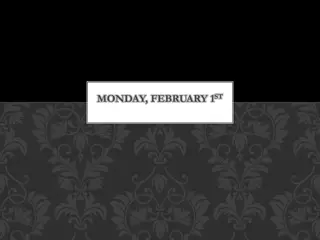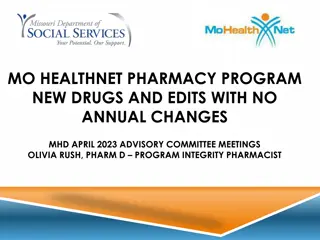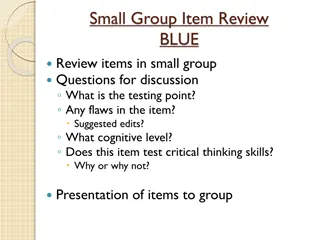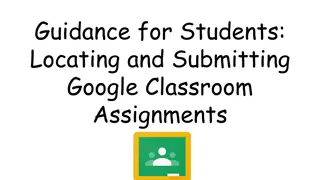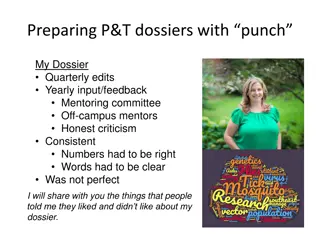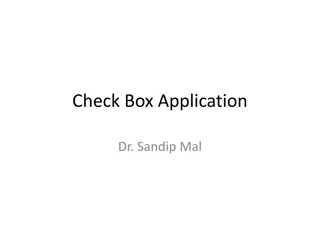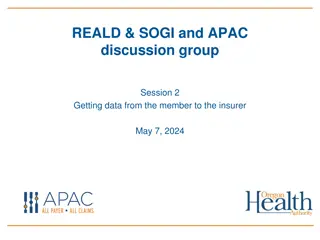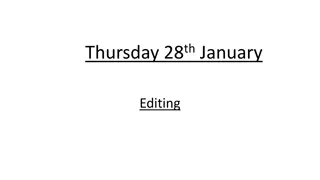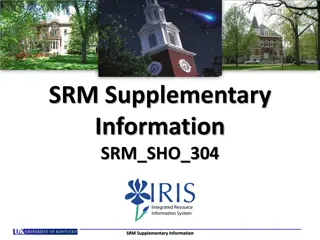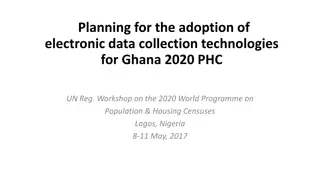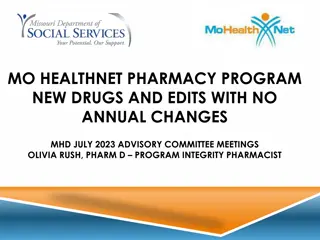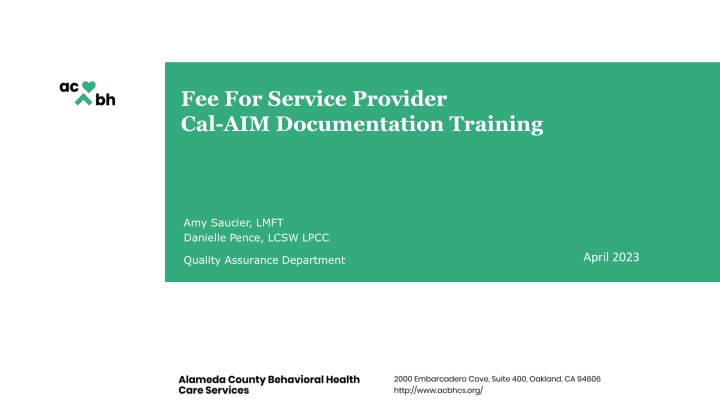
Cal-AIM Documentation Training for Service Providers 2023
Enhance your understanding of client referrals, Cal-AIM access criteria, and documentation templates in the Cal-AIM Documentation Training for Service Providers led by Amy Saucier, LMFT, and Danielle Pence, LCSW. Learn about changes in pre-authorization requirements and the No Wrong Door policy under the California Advancing and Innovating Medi-Cal initiative.
Download Presentation

Please find below an Image/Link to download the presentation.
The content on the website is provided AS IS for your information and personal use only. It may not be sold, licensed, or shared on other websites without obtaining consent from the author. If you encounter any issues during the download, it is possible that the publisher has removed the file from their server.
You are allowed to download the files provided on this website for personal or commercial use, subject to the condition that they are used lawfully. All files are the property of their respective owners.
The content on the website is provided AS IS for your information and personal use only. It may not be sold, licensed, or shared on other websites without obtaining consent from the author.
E N D
Presentation Transcript
Fee For Service Provider Cal-AIM Documentation Training Amy Saucier, LMFT Danielle Pence, LCSW LPCC April 2023 Quality Assurance Department
Learning Objectives At the conclusion of this training, participants will have a better understanding of the following: Receiving client referrals Cal-AIM Access Criteria and Medical Necessity definitions New documentation templates 2
Receiving New Clients Pre-authorization of FFS outpatient therapy services is no longer required and providers no longer need to submit Request for Continued Services (RCS) forms to the ACBH Utilization Management team. With this change, clients may now reach out to providers directly to request mental health treatment services. It is the provider s responsibility to verify eligibility and ensure clients meets Access Criteria for Specialty Mental Health Services. A number of training videos are available on the ACBH Provider Website that walk providers through the process of verifying eligibility and other steps required when taking on new clients. Today s training will focus on understanding Access Criteria and new documentation requirements. 3
California Advancing and Innovating Medi-Cal (CalAIM) CalAIM is a California initiative led by the Department of Health Care Services (DHCS) that aims to provide broad delivery system, program, and payment reform across the Medi-Cal system. A number of CalAIM initiatives have already been implemented, including changes to Criteria for Access and Documentation requirements. 4
No Wrong Door To remove barriers to care, Cal-AIM rolled out the No Wrong Door policy. Mental Health Plans (ACBH and its providers) are still expected to serve individuals with moderate to severe symptoms and refer those with mild to moderate symptoms to the Managed Care Plan (e.g. Kaiser, Alliance). However, No Wrong Door allows Medi-Cal providers to assist beneficiaries regardless of which delivery system they request services from. Clinically appropriate services can begin through any door regardless of a co-occurring diagnosis. Beneficiaries can maintain established therapeutic relationships. Non-specialty mental health services (NSMH) and Specialty Mental Health Services (SMHS) can be provided concurrently, as long as they are coordinated and not duplicative. If during the assessment process it is determined a beneficiary would benefit from a referral to a different type of provider, the provider assists the beneficiary in transitioning to a more appropriate provider. BHIN 22-011 5
Understanding Access Criteria and Medical Necessity BHIN-21-073 6
What Changed with Cal-AIM? To remove barriers to accessing care, the criteria to access Specialty Mental Health Services (SMHS) were separated from Medical Necessity. A diagnosis is no longer a prerequisite for accessing needed SMHS or Drug Medi-Cal (DMC/DMC-ODS) outpatient services. Outpatient services rendered in good faith are reimbursable prior to determination of an official diagnosis. The Included diagnosis list is no longer used to determine if an individual can receive services. 7
SMHS Medical Necessity Definition of Medical Necessity was brought into alignment with Welfare and Institutions Code 1418.402(a) for those 21 and over and with Section 1396(r)(5) of Title 42 of the US Code for Individuals under 21 years of age. 8
SMHS Access Criteria Adults Age 21+ Must meet both of the following criteria: Criteria 1: The beneficiary has one or both of the following: Criteria 2: The beneficiary s condition is due to either of the following: and Significant impairment, where impairment is defined as distress, disability, or dysfunction in social, occupational, or other important activities. And/or A reasonable probability of significant deterioration in an important area of life functioning. or A diagnosed DSM mental health disorder A suspected mental disorder that has not yet been diagnosed. 14184.402(f)(1)(A), Except for psychiatric inpatient hospital and psychiatric health facility services a mental health diagnosis is not a prerequisite for access to covered SMHS. 9
SMHS Access Criteria Youth Under Age 21 Must meet either of the following criteria: The beneficiary meets both of the following requirements The beneficiary has a condition placing them at high risk for a mental health disorder due to experience of trauma as evidenced by any of the following: The beneficiary has at least one of the following: A significant impairment A reasonable probability of significant deterioration in an important area of life functioning A reasonable probability of not progressing developmentally as appropriate. A need for specialty mental health services, regardless of presence of impairment, that are not included within the mental health benefits that a Medi-Cal managed care plan is required to provide. and The beneficiary s condition is due to one of the following: A diagnosed mental health disorder A suspected mental health disorder that has not yet been diagnosed. Significant trauma placing the beneficiary at risk of a future mental health condition, based on the assessment of a licensed mental health professional. Scoring in the high-risk range under a trauma screening tool approved by the department or Involvement in the child welfare system Juvenile justice involvement Experiencing homelessness Optional Trauma Screening tools: Pediatric ACES and Related Life-Events Screener (PEARLS) tool ACE Questionnaire 10
Z Codes During the assessment phase when a diagnosis has yet to be established, the following codes may be used: ICD-10 codes Z55-Z65, Persons with potential health hazards related to socioeconomic and psychosocial circumstances may be used by all providers as appropriate during the assessment period prior to diagnosis and do not require certification as, or supervision of, a Licensed Practitioner of the Healing Arts (LPHA) or Licensed Mental Health Professional (LMHP). ICD-10 code Z03.89, Encounter for observation for other suspected diseases and conditions ruled out, may be used by an LPHA or LMHP during the assessment phase of a beneficiary s treatment when a diagnosis has yet to be established. In cases where services are provided due to a suspected disorder that has not yet been diagnosed, options are available for an LPHA or LMPH in the CMS approved ICD-10 diagnosis code list, which may include Z codes. For example, these include codes for Other specified and Unspecified disorders, or Factors influencing health status and contact with health services. 11
ACBH Screening Tool To assist with establishing the Access Criteria, ACBH has developed a Behavioral Health Screening Tool for Outpatient Services. The tool serves as a Quick Reference Guide and includes the information noted in the previous slides. The use of this tool is optional but highly recommended. NOTE: This tool is different than the standardized Screening tool developed by DHCS. That tool is being used by Managed Care Plan and Mental Health Plan Call Centers when clients first contact them to request services. 12
ACBH Screening Tool The second page of the tool contains the screener for Intensive Service Needs. Screening for Intensive Care Coordination, Intensive Home Based Services and Therapeutic Foster Care is a Medi-Cal requirement for ALL beneficiaries under 21 years old. 13
Documentation Redesign BHIN 22-019 14
Documentation Redesign: Non-Hospital Services A Client Plan is still required for the following: Targeted Case Management (TCM) = Case Management Intensive Care Coordination (ICC) Intensive Home Based Services (IBHS) Therapeutic Foster Care (TFC) Therapeutic Behavioral Services (TBS) Narcotic Treatment Programs (NTP) Short-Term Residential Therapeutic Programs (STRTP) Psychiatric Health Facilities (PHF) Special Treatment Programs with Skilled Nursing Facilities (STP-SNF) Mental Health Rehabilitation Centers (MHRC) Community Treatment Facilities require a Needs and Services Plan (NSP) Youth in Social Rehabilitation Programs Peer Support Services Discharge Care Plans Changes: Standardized SMHS Assessment Requirements. Removal of set timeframes for assessments. Removal of the requirement to complete assessments and client plans prior to providing services. Introduction of a Dynamic Problem List. Removal of Client Plans for most services. Simplified Client Plans for TCM and Peer Support: Client Plans for these services must be documented in a Progress Note. 15
See SMHS Documentation Manual for more details SMHS Assessment Domains Domain 1: Presenting Problem/Chief Complaint Current and History of Presenting Problem Current Mental Status Impairments in Functioning Domain 5: Psychosocial Factors Family Social and Life Circumstances Cultural Considerations Domain 6: Strengths, Risks and Protective Factors Strengths and Protective Factors Risk Factors and Behaviors Safety Planning Domain 2: Trauma Trauma Exposures Trauma Reactions Trauma Screening Systems Involvement Domain 7: Clinical Summary, Treatment Recommendations, Level of Care Determination Clinical Impressions Diagnostic Impressions Treatment Recommendations Domain 3: Behavioral Health History Mental Health History Substance Use/Abuse Previous Treatment Services Domain 4: Medical History and Medications Physical Health Conditions Current and past Medications Developmental History Assessments and re-assessments must be completed within a reasonable time frame and in accordance with generally accepted standards of practice. 16
Assessment Template The Assessment Template has been updated with the seven Domains. It s use is optional but highly recommended. Forms are fillable and available on the FFS page of the ACBH Provider website. If using an Electronic Health Record, you may add items but do not remove any items for the assessment template. Demo Assessment Template 17
Pediatric Symptom Checklist (PSC-35) There have been no changes to the requirement to complete the PSC-35. PSC-35 is a psychosocial screener designed to facilitate the recognition of cognitive, emotional, and behavioral problems so that appropriate interventions can be initiated as early as possible. There are two versions. One to be completed by an adult/caregiver and the other for a youth over 11yrs old (Y-PSC-35). The Pediatric Symptom Checklist (PSC35) must be completed by day 60 of Episode Opening, every 6 months and at discharge. If not completed, an explanation of barriers to completion should be documented in the notes. 18
Problem List Problem Lists are a NEW requirement that must be included in every chart. Fillable forms are available on the FFS page of the ACBH Provider website. These are a common tool in physical healthcare and function as a one stop shop to capture the client s needs. The Problem List is a dynamic log and should be updated at the time of initial Intake and as new problems are identified or existing problems are deferred or resolved. 19
Problem List Details All problems must be codified using ICD-10 Codes. Diagnoses (ICD-10 codes) should be added by providers acting within their scope of practice. If a relevant problem/diagnosis is outside the provider s scope of practice (e.g. Diabetes) but was reported by the client, check the column for Identified by Beneficiary or Support when adding the problem. The Description field must contain the ICD-10 Code description. Indicate the name and title of the provider that added, or removed the problem. Note the date the problem was added, or removed (resolved, deferred) from the list. 20
Progress Notes With Cal-AIM, Progress Notes have been simplified. Fillable forms are available on the FFS page of the ACBH Provider website and include all of the Medi-Cal required elements. Progress Notes include the following two required narrative sections: A narrative describing the service, including how the service addressed the beneficiary s behavioral health need (e.g., symptom, condition, diagnosis and/or risk factors). Next steps including, but not limited to, planned action steps by the provider or by the beneficiary, collaboration with the beneficiary, collaboration with other provider(s) and any update to the problem list as appropriate The last page of the Progress Note Template includes a section for Case Management Care Plans. Per Cal-AIM, these must now be documented as a narrative in the Progress Note. Demo Progress Note Template 21
Case Management Care Plans 22
Progress Note Timeframes Routine Services: Documentation should be completed within 3businessdays. If a note is submitted outside of the three business days, document the reason the note is delayed. Late notes should not be withheld from the claiming process. Crisis Services: Documentation should be completed within 24 hours. Progress Note timeliness issues do not lead to disallowances. 23


